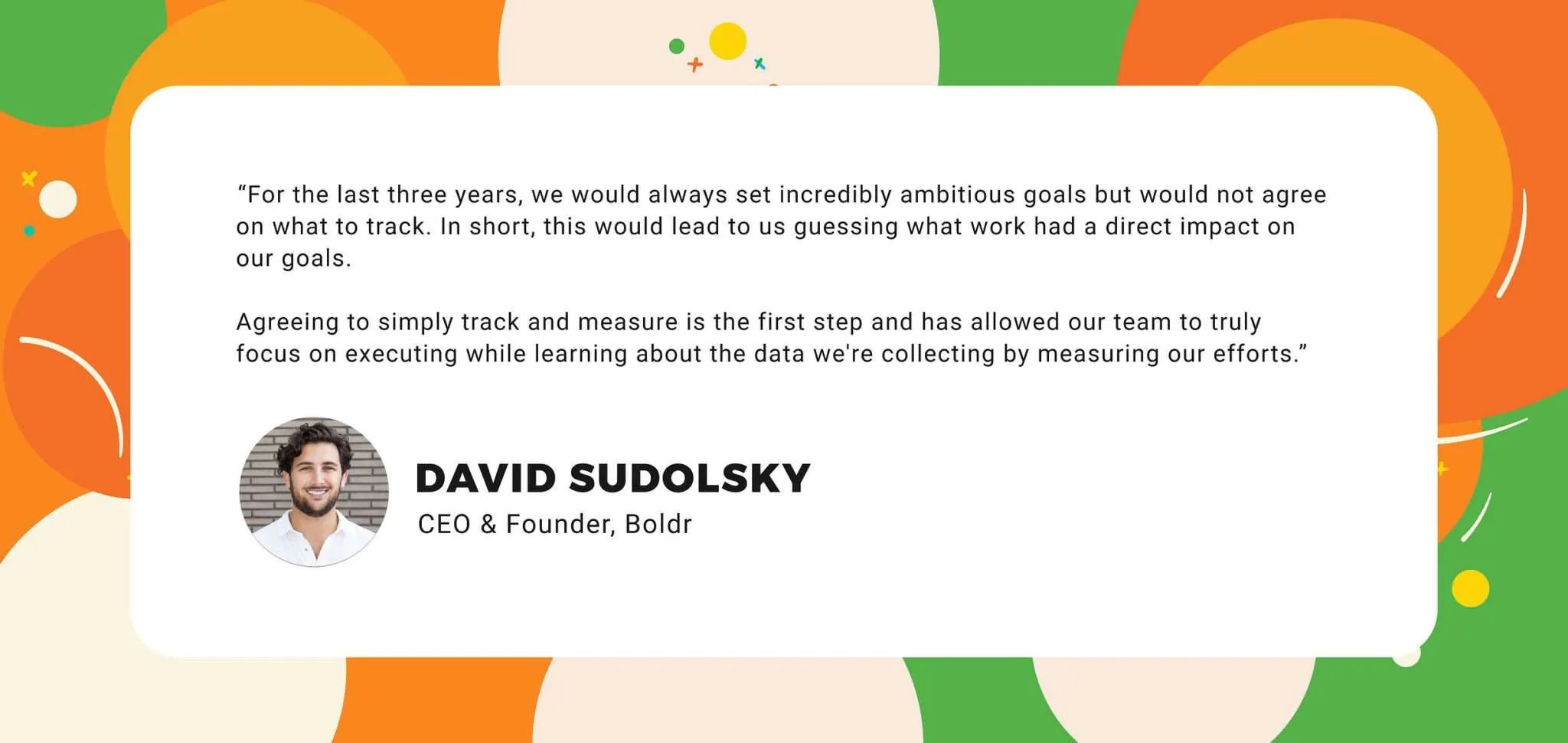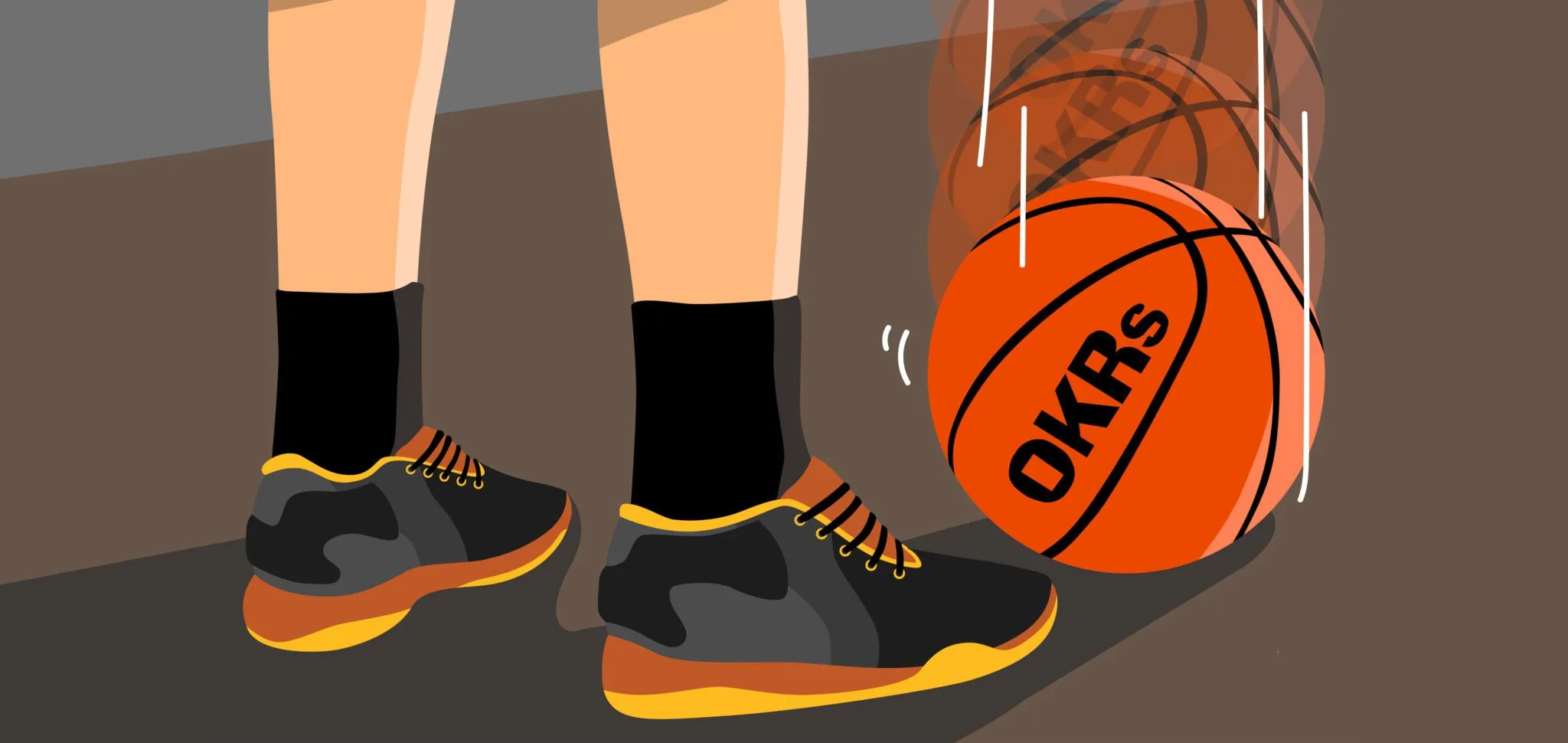As an impact-focused, mission-driven company, Boldr has always committed to operating against three core pillars:
- Company: Serving our Company (more concretely, our Team Members)
- Clients: Serving our Clients (more concretely, supporting client health and success)
- Community: Serving our Communities (more concretely, investing time and money where we live and work)
The way we work and behave—and treat each other—has reflected these values in spirit, especially during the extraordinary times that the world faced over the past 12 months (and at the time of publishing, still ongoing).
As we’ve grown (on pace to pass 500 Team Members very soon), we realized that the informal approach to some aspects of our culture were doing a disservice to the magnitude of work we were doing. We were telling a story, but we hadn’t put ourselves in position to tell our story concretely, at depth, brought to life with data, impact and outcomes.
Our stories were just that: stories. Two-dimensional in a sense.
In 2021, we wanted to take a more deliberate step forward and support our rapid global expansion. In 9 months, we went from having a single office in the US and Manila, to having teams in Tacloban, Canada, Mexico, and South Africa; and we wanted to move forward with our values placed even more concretely as the foundation of all we do. With the framework we built, our ultimate goal is to ensure each team member was able to draw a straight line between their work and each of the three pillars we pursue as a company.
So why did we need to rethink OKRs for Social Impact-Driven Companies?
OKRs are one of the most popular organizational planning tools around. I’ve had the luxury of leading the implementation of OKRs at a handful of companies and the process always tends to start out with vigor, get stuck in missteps, and then after a cycle or two, find it’s authentic fit and place at the company.
The challenge?
Each one of those cycles is somewhere between a quarter and a year.
Which can make the OKR process leave a horrible taste in your mouth, one even MSG can’t mask.
Last year, Boldr set out upon its OKR journey and faced a similar challenge, compounded by all the disruption 2020 brought to bear.
Needless to say, as COVID and quarantines hit, we pulled away from our OKRs dramatically. We were too focused on two primary priorities:
- Team Member Safety, Health, and Success
- Client Performance, Health, and Success
We rapidly recalibrated how Boldr operated; in 48 hours we made the switch from a co-located team to one that was fully remote, all without skipping a beat with our client programs. (We’re still proud of this effort.)
In a way, the pandemic saved us from ourselves. The forcing function put us in position to better understand the metrics that truly moved Boldr forward successfully, holistically. As we set out to pursue OKRs in 2021, I asked to take the lead.
Related Read: Boldranians Take on COVID-19
I used the experiences I’d gathered at companies like Chartbeat, LiveIntent, and Help Scout to reset our approach to setting OKRs, get everyone bought in on principle and approach, and then, set out against establishing our OKRs more concretely—and getting them right this time.
A refresher or “What are OKRs again?”
OKRs stand for: Objectives and Key Results. There’s an incredible amount of information written on the topic that a Google Search will net you; but the bottom line is that it represents a framework, well-adopted globally, for setting “Objectives” (things you want to achieve, ideally measurable, but in the case of younger companies, things you want to get good at measuring) and then, identifying the “Key Results” (things which if achieved you believe would make your Objective possible; or said another way, hitting your Objectives is impossible without these Key Results being achieved).
OKRs tend to “ladder” in the sense that a company has OKRs and each unit, division, team, individual, should be able to map their own OKRs to the company. In a sense then, the Company can’t hit its OKRs without teams doing the same, and inverted, if teams hit their OKRs, the company should be on the path toward hitting its goals.
OKRs and Newton’s Third Law
The purpose of OKRs is to define priorities (objectives) and outline the leading indicators of success against those priorities. With those defined, individual teams and team members can think of the actions they can take to drive those leading indicators and ultimately make progress against and achieve those priorities.
In spirit, the process here becomes a perfect example of Newton’s Third Law. The perfect action of a leadership team setting Objectives and Key Results should have a reaction that is the company buying into those Objectives and Key Results and responding with actions they believe they can take to make both possible.
So why doesn’t that always happen? Let’s think of a ball dropping, to start. Let’s think of the OKR process as someone bouncing a basketball.
Why OKRs Fail: Extending, and then Abusing, an Analogy
If you think then, of Newton’s Third Law, and apply it to the OKR setting, why do OKRs fail?
To extend the analogy, they fail because the energy involved in the process isn’t directed properly, captured correctly, or reflected accurately.
OKRs fail when the ball is literally dropped.
When leadership sets OKRs that lack context, that aren’t anchored in reality, that focus solely on what but give no nod to why, how, when, or with what additional support required—when OKRs are set blindly (or what appears to be blindly), the OKR(s) are doomed for failure even as they’re set.
If we think of Objective setting as top down, as dropping a ball, well, we have gravity on our side. No matter how much energy we put into our Objectives, gravity and org structure is going to make it feel like we did our part and delivered them to the team. We should feel like gravity makes our life easier. We should instead think of what it would be like if we had to push our Objectives up; with org structure and gravity working against us.
We’d prioritize more.
We’d put more energy into it.
We’d acknowledge that hard work is on our side to make sure the Objectives reach their destinations—our team members.
OKRs fail for the above reasons. When they’re set, how they’re communicated, and how ready the team is to receive them.
OKRs also fail when people set the wrong Objectives and Key Results. There can be an obsession with measurement at times; but the best teams and companies know that picking the wrong Objective is the worst possible thing to do when you don’t know what the right OKRs should be.
The best companies know that there is a time to pick clear OKRs and there is another to acknowledge your infancy in a particular area or discipline and focus on hypothesizing, experimenting, and learning along the way.
Sometimes the best OKR is committing to finding the right OKR and the right things to measure, first.
Total Team Member Impact, a Practical Rejection of Singular, North Star Metrics

Our first step was to put our people and their goals, holistically, at the center of what we measure. We started by introducing “Total Team Member Impact,” the operating metric that guides our future.
Total Team Member Impact is our commitment to helping each Boldr Team Member—each Boldranian—understand the holistic impact of their time, work, and efforts at Boldr. We’ve aligned the impact against three metrics that tie specifically to our values. It’s a framework we can use to start connecting the values we espouse with the work we do on a daily basis.
Also read: Building a Global, Purpose-Driven Outsourcing Organization
Company = Team Member Health and Wellness, Heart, Body, Mind, and Soul
We’ve put this metric first for a reason. Our objective here is to ensure we understand how our Team Members are doing holistically. Not because it increases productivity, or because it drives more revenue—but because the right thing to do is to make sure our Team Members are doing well.
At the end of the year, each Boldranian will be able to speak clearly and tangibly about the impact they’ve made on their own health and wellness, and the role Boldr has played in creating space for that to happen.
Client = Clients Supported, Team Members Employed, and Revenue Generated
This is second for a reason, because it acts as a bridge, the enabler that connects our people to the third pillar, our impact.
In this case, we’re focused on understanding simple, basic metrics, such as how many Team Members we’re employing, what the average revenue and profit per Team Member is. Part of our Objective as a company is to bring Opportunity to talented people around the world, who otherwise may not have access to it.
At the end of the year, each Boldranian will be able to understand the employment and economic impact we’ve had by understanding the jobs we’ve created and the companies we’ve helped scale to new heights—and more importantly, their role in this process.
Community = Social Impact
This is third. Not last, but it is the end goal—we are building a company, we are hiring people, we are supporting clients, and we are channeling all of that energy to working in impactful ways because our goal is to make a positive impact on the people we touch and the communities where we live and work.
Here, we’re quantifying impact based on the contributions we make (time, money) and that we inspire (by our Team Members and through our clients and partners). At the end of the year, each Boldranian will be able to understand the social impact we have made (through the time and money we’ve invested) and the social impact we have inspired (through programs that inspire the people and organizations we work with to invest their own time and money into the causes we’re supporting).
Total Team Member Impact means that each Boldranian will understand the impact they’ve made, and the role they’ve played, in the total impact Boldr has made.
You’ll notice that we didn’t limit ourselves to one metric. Our Team Members are three-dimensional. We value them holistically, not only because of their contribution in one area. One of the toughest breakthroughs was rejecting the mainstream tendency of choosing a “single north star metric.” Why a single start? Why not three?
Why not build our business with triangles, which are the strongest shape because of their ability to withstand tremendous pressure, while also, allowing for an infinite set of design manifestations.
We quickly became enamored with a comprehensive view of our Team Members reflected through three axes.
How to Set OKRs with Varying, Sometimes Nonexistent Sets of Information
One crucial thing to note is that “OKRS are NOT for Command and Control. OKRs [are the best approach] if you want to direct your people toward desired outcomes and trust them enough to figure out how,” Christina Wodtke, Lecturer at Stanford & CEO at Eleganthack.
For our team, clarifying the connection between our values and our work has been energizing. It’s momentum-building. It’s also simple, which is important for authentic evangelism. Joining meetings of all sorts, and hearing team members shouting out how they’re doing “heart, body, mind, soul” or revising our internal lexicon to emphasize how many Team Members we find careers for, serving our clients on the front line, is heartening.

The connection, the spirit, is being evangelized. More tangibly than ever before. We still had more work to do.
Each of the pillars in our Total Impact Metric was at a different level of sophistication with respect to our ability to set goals and measure progress against it.
Here, we had some debates.
On the Client side, for example, the goals and priorities and metrics were simple. Very traditional metrics against which goals and forecasts could be set. We understood what growth would look like and would require and as a result we were able to set clear, precise goals for 2021. These are the clearest goals we can set—not the simplest, but the clearest.
The same could not be said for Health & Wellness. How does one quantify “Heart, Body, Mind, Soul?” We embraced the challenge. We didn’t focus on our inability to quantify it now; instead, we made our OKR about exploring and experimenting with ways to quantify the impact and measure success.
One incredibly powerful KR that resulted from this focus and emphasis: each manager at Boldr, each person who leads a team, has as one of their own metrics of success, proactively making space for and ensuring their team members take PTO.
The act of making PTO a priority, making space for it, and helping their Team Members focus on “how” they can take PTO fully, has been a runaway success in the most positive of ways for our team. We are already seeing the impact it’s having on our team members’ spirits, and we love how we’ve codified their taking PTO as an expectation and as a responsibility that falls on their managers to enable.
Once we had clarity around this Total Team Member Impact Metric, we needed to take the next step of aligning against a framework that would help us achieve maximum value against these priorities and pillars. Turning to OKRs became a more realistically informed approach in pursuit of them.
So How Do We Get OKRs Right in 2021?
“Not every team that decides to implement OKRs will succeed in doing so.” — Ivan Osmak
Simply put, we avoid the pitfalls outlined above.
Working backward, we acknowledge that the more effort we put into building our OKRs, the less effort our team will have to carry in reciprocating and carrying them forward.
Let’s set realistic objectives. Let’s set goals where we know what we can and need to do to achieve them, based on our team, our potential and our values.
This is abundantly clear in the Client > Financial Objectives we will set for 2021. It’s not a perfect science but we have incredible visibility and confidence in our abilities here.
Juxtaposed, when you think of our Company > Developmental and Community > Social Objectives, we know generally the kind of company we want to be, the things we’ve done that have worked, and what we believe is important going forward. With that context, we have to resist setting hard outcomes until we’re sure we’ve chosen the right ones. As a result, we will focus more on tracking and reporting against initiatives we believe in, reporting back, with an emphasis on learning.
Getting OKRs right requires establishing an authentic framework, first.
It then means acknowledging where you are against your ability to truly measure success across the OKRs you’ve created. Giving your team space, especially early in the OKR process, to focus on what can be measured, what should be measured, and, on what actually makes a difference and an impact, ensures more buying in on the process. More participation.
It also ensures you don’t chase the wrong numbers; because you can or because you forced yourself to chase something.
Related Read: Evolution of Business Process Outsourcing: From Tactical to Human-Centric
The Most Successful OKR Process, to Date
As we wrap up Q1, we’re seeing excellent momentum as a business. We’re seeing aha moments across the company as people start connecting to metrics that matter and make an impact. And we’re seeing greater unity across the company about our values, about the work we do and the way we do it.
Yes, OKRs are about metrics and performance; however OKRs are also about alignment and about creating clarity and momentum against what the business needs to do to be successful. Getting nearly 500 people rowing in the same direction in Q1 is part of being deliberate about the OKR process. Whereas some companies may have scrambled to get OKRs released on January 1, we focused instead on getting people bought in on OKRs, frameworks, and then the specific actions through the first 6-8 weeks of 2021. This allowed us to close out 2020 strong, without distractions, and allowed us to move in parallel to start Q1 2021.
“When personal objectives are directly and clearly connected to the broader goals of the company, they’re suddenly more inspiring, less myopic.” — Angus Davis, Founder and former CEO of Upserve.
Which is why we’re on pace for our best quarter ever, while having set up what looks to be our best quarter ever.
All while having a healthier, happier, more successful team moving us forward.
We’ll hit speed bumps along the way, we know. For now, we’re focused on being Happy about how we feel, Proud of what we’ve accomplished, and Not Yet Satisfied about how far we’ve come as there’s so much more left to do. We’ll hit speed bumps along the way, but with the approach we’ve taken the entire company understands how we’ll go about recalibrating, adjusting, getting bought in, and then moving forward anew.
The OKR process is about more than setting objectives for a particular time. It’s about reinforcing to the entire company how you go about setting those objectives in the first place.
For companies who have struggled with OKRs in the past; or for companies looking to pursue OKRs and implement them for the first time, we hope you find the above helpful. And if you’d like to learn more about our experience, drop a line: suneet@boldrimpact.com.


